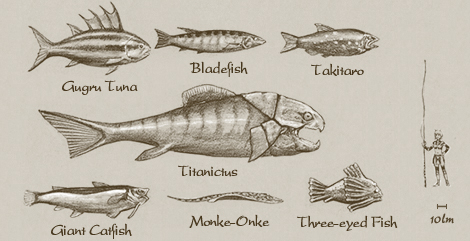When the Fishermen's Guild saw how fiercely fishing enthusiasts were competing to catch the largest fish, they decided to begin a new event known as "Fish Ranking" to promote an even greater interest in hauling up these underwater behemoths. The editorial office has received the cooperation of the Fishermen's Guild in providing a run-down of the fish likely to be ranked in this new competition.
Eminent biologist Professor Clavauert has perused the information below, and removed all exaggerations and fairy tale facts. However, we would like to state for the record that these explanations might not be one hundred percent accurate.

Gugru Tuna
Length: Approx. 120 Im.
The Gugru tuna is a large fish that moves in schools, swimming swiftly about near the surface of the Gugru Blue.
They are characterized by their large dorsal fin and the vivid stripes that run along their body. Feeding mainly on Bastore sardines, these fish are often caught by trolling, and are prized in the Far East as an ingredient for expensive sushi.
Giant Catfish
Length: Approx. 112 Im.
This scale-less, slippery-skinned fish prefers to dwell in the muddy beds of lakes and marshes that are abundant with aquatic plant life. They have small eyes due to the vision-restricting environment which they inhabit, but have developed feeler-like whiskers to aid in detecting their prey. Giant catfish slide stealthily up to their victims, sensing the slightest vibrations with their whiskers, and swallow frogs and other small creatures whole with their huge mouths.
These silent predators were originally found only on the Quon continent, but have been recently discovered in Mindartia. It is thought that someone deliberately introduced the species, and local biologists fear a reduction in the numbers of native fish.
Monke-Onke
Length: Approx. 110 Im.
The monke-onke is a freshwater ray found in the lakes and rivers of southern Mindartia and Elshimo Island. They conceal their brightly speckled bodies beneath the sand and prey upon crayfish and other similar life forms.
The monke-onke shares its name with an ancient Windurstian tribal chief, a well-known gourmand. According to one story, the ray was so named because of its resemblance to the huge fans used by the tribal chief's Mithran servants when he took his meals.
The ray's tail harbors a venomous sting so potent that it can fell a fully-grown chocobo with one strike.
Three-eyed Fish
Length: Approx. 78 Im.
The peculiar three-eyed fish makes its home in the Sea of Shu'Meyo. Many mysteries still surround its ecology, but the three-eyed fish's territorial instincts and amazing powers of survival are well known—one fisherman tells of carting a specimen to a town three days away, only to be bitten by the fish as it attempted to jump out of the opened net upon arrival.
According to Professor Clavauert, the three-eyed fish was once a much different species altogether. He states that an environmental cataclysm in the distant past affected all life on Vana'diel, with the pollution concentrated most densely in the Sea of Shu'Meyo—the supposed center of the disaster. Professor Clavauert points to the existence of the three-eyed fish as direct proof of his claims.
Bladefish
Length: Approx. 114 Im.
This saltwater fish takes its name from its silver, spindle-shaped body, and razor-sharp teeth. The bladefish has been sighted along the southern coasts of both the Quon and Mindartian continents, and is thought to be a migratory species. The contents of a bladefish's stomach have shown its main prey to be Bastore sardines and bluetails, however bladefish teeth marks found on the shells of uragnite carcasses attest to its voracious appetite. They were once believed to gnaw on the hulls of boats, with fishermen fearing the bladefish to be the cause of sinking ships, but this superstition was later replaced with the more likely theory of Sahagin saboteurs.
Takitaro
Length: Approx. 94 Im.
A legendary fish thought to inhabit a lake somewhere on the Quon continent. The takitaro remains an elusive creature until this day, but folklore tells the story of live takitaro being transported to the Tavnazian Marquisate at great cost by a Far Eastern king in gratitude for the loan of a warship used to quell internal strife. A friar fond of fish is then said to have moved the takitaro to a different lake, with the population growing so large as to bless the monastery with a veritable banquet once a month.
Takitaro are extraordinary long-lived and grow to enormous size over the span of decades, making them a universal symbol of fortune. The vigor and energy supposedly provided by these fish is also a widely held superstition.
Titanictus
Length: Approx. 200 Im.
This massive, carnivorous fish is thought to have ruled the primeval seas of Vana'diel. Belonging to an ancient species of "armored fish" that have a plate of bone covering their heads, the titanictus had only been found in fossilized form until fished up by adventurers in recent years.
Despite its huge jaw, the titanictus is too slow to catch smaller, quicker fish, and relies on a diet of crustaceans and cephalopods to feed its great bulk.
Illustration by Mitsuhiro Arita